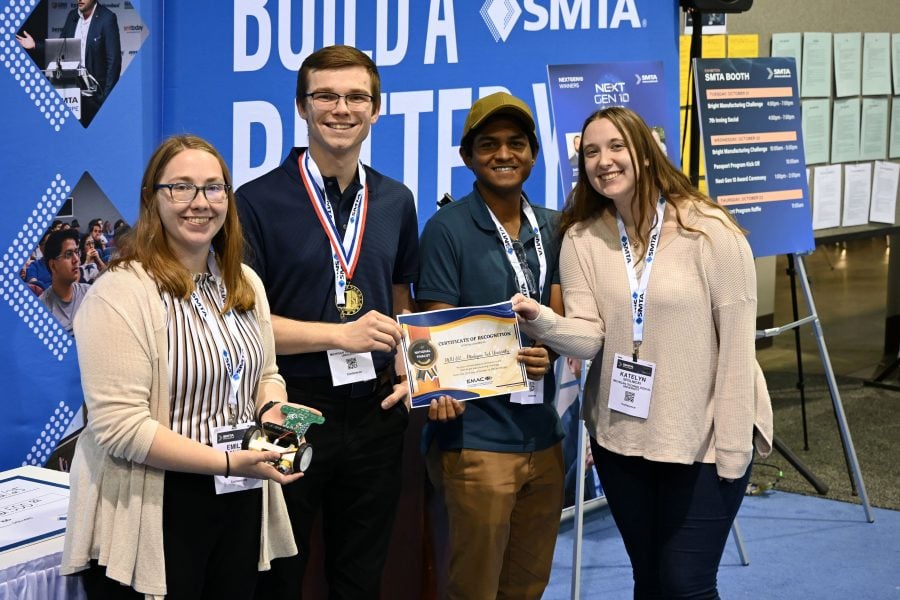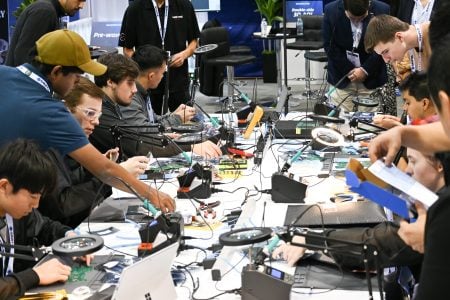Michigan Tech undergraduates Emily Daley, Peter Kocour, and Katelyn Spolnicki, and graduate student Rishin Patra secured 3rd place at the recent 2025 Bright Manufacturing Challenge.
The 8-week, national competition is sponsored by EMAC, the Electronics Manufacturing and Assembly Collaborative. It’s an immersive, hands-on experience for student teams who design, fabricate, and test a custom printed circuit board (PCB) to serve as the control center for a robot. The multidisciplinary competition is open to any team of 2–5 members (current college students or recent grads). This year over a dozen teams from around the country took part, including Michigan Tech.
Round 1 (PCB Design) of the challenge took place in July 2025 as a remote competition. The MTU team placed among the top 8, securing their spot in Rounds 2-4 of the challenge in Rosemont, Illinois on October 21-22 during the SMTA International Conference and Exhibition (SMTAi).
“It was absolutely incredible to witness how much effort the students put in leading up to the final challenge, “ said Professor Christopher Middlebrook, who traveled with the team. “They were able to build on their momentum all the way down to the very last minute of the competition.”
Daley, Kocour, Spolnicki, and Patra are all electrical engineering students and members of the IPC-Student Electronics Chapter at Michigan Tech. The chapter focuses on industry connections, plant tours, conference attendance, and all other things related to the printed circuit board or electronics industries.
Back in May, when the Bright Manufacturing Challenge was first announced, Daley and Rishin decided to form a team, later discovering Spolnicki and Kocour were also interested in getting involved, creating a full team from Michigan Tech.
“I served as team leader, Rishin took on the PCB design role, Peter became the mechanical lead, and Katelyn was the programmer,” said Daley. The team booked Zoom meetings over the summer to coordinate. “We were all in different locations–Peter in Wisconsin, Katelyn in Texas, Rishin in Houghton, and I was in the Lower Peninsula and other locations at times.”
During Round 1 in July, each team was given a basic circuit schematic to adjust and design with an additional feature that would give their robot some sort of advantage. “After running through many options—LED array, camera module, speaker—we finally decided to go with an LCD module that would allow for adjustable settings, as well as a display of our team logo,” said Daley.
“We also began looking into funding options. We knew if we made it to the final round, we would have a lot of expenses on our hands.”
Michigan Tech’s ECE department helped fund expenses, which allowed the team to order a prototype of their design and test it in the Michigan Tech Plexus Innovation Lab. Patra and Kocour designed the robot’s 3D housings for its motors and battery. Daley soldered together some 18650 battery holders for testing purposes, allowing the team to test the robot without needing to walk around with a DC power supply.
After working together as a team for 8 weeks, the students spent their last night on campus burning the midnight oil prior to their departure. “Katelyn and Rishin worked on the code and a mock-up course, and finished up the mat for full testing. After working for a few more hours, we eventually broke up to get an hour of sleep before our departure to Rosemont the next morning,” Daley shared.
Each year SMTAi brings together a community of electronics manufacturing innovators from across the globe, with an emphasis on collaboration and discovery. Rather than in a closed conference room, Rounds 2-4 of the Bright Manufacturing Challenge purposefully took place right on the SMTAi exhibit floor—a high-energy, high-traffic location, with a lot of people coming around to watch and support the students as they built their robots. The students responded well, enjoying conversation and interaction with conference attendees.
Once the competition at MTAi began, the Michigan Tech team sailed through Rounds 2 and 3. Then came the Round 4 grand finale—the robot challenge. Teams were given just 4 hours to assemble their robots on site.
“In less than 2 hours—not even half the allotted time—our robot was assembled and ready to go. We took it back to our hotel early for one last late night, which we spent mostly refining the programming,” said Daley. “This was a time-based challenge and we knew we were up against some fast robots.”
The next morning, the team headed back to the competition early, to test the robot on the challenge course, and again, further adjust the programming.
With a few hours still to go, the team brought their robot back to their hotel, laid out their homemade mat in the hotel lobby, and tested the logic, continuing to fine tuning the programming until it was time to head back.
“Even though we had a working prototype before arriving, as an electrical engineering student, I couldn’t help but worry that something might not power up correctly or that the robot might go off track during testing,” said Patra.
“Fortunately, it didn’t release any ‘magic smoke,'” he shared. “After uploading the program to the microcontroller it ran exactly as we intended during the competition! Seeing our design and testing come together in that instant made all the late nights worth it.”
“Getting our code to function the way we had imagined was a challenge. There were many, and I mean many, late nights trying to get the robot programmed in a way that navigated the course both with accuracy and with speed,” adds Kocour.
“One of the biggest lessons I learned was the importance of having a solid backup plan,” adds Rishin. “We carried extra batteries, chargers, programmers, and spare components and those saved us multiple times during the competition. For example, chargers and programmers weren’t provided at the event, but because we brought our own, we were able to keep everything running smoothly.”
In addition to the Michigan Tech Huskies’ 3rd place win, the PC Bros/Palomar College team earned 1st place at the Bright Manufacturing Challenge, and the River Hawks team from UMass Lowell earned 2nd place.
“Overall, the challenge was very fun,” Daley concludes. “There were times where it seemed like some information was missing, and some rules seemed to change—but that is prime engineering experience.”
Prof. Middlebrook started the Michigan Tech Electronics Hub last year, bringing together learning, research, and industry to support a wide range of learners and job seekers.


